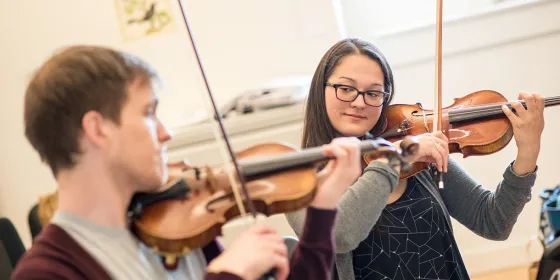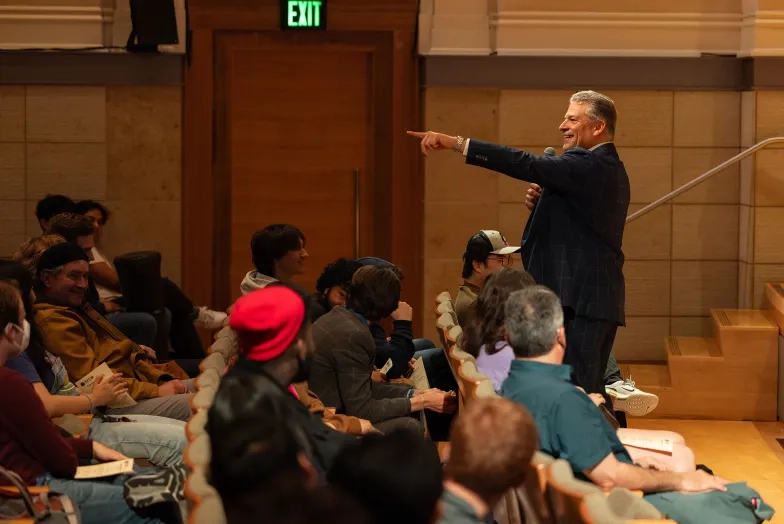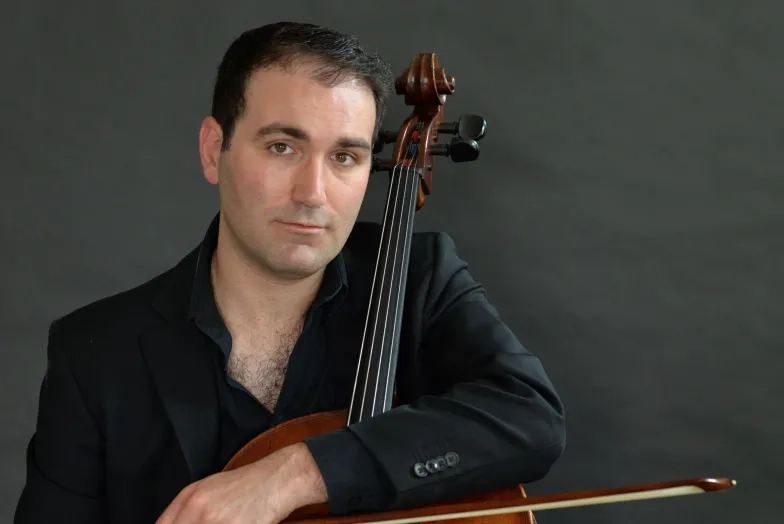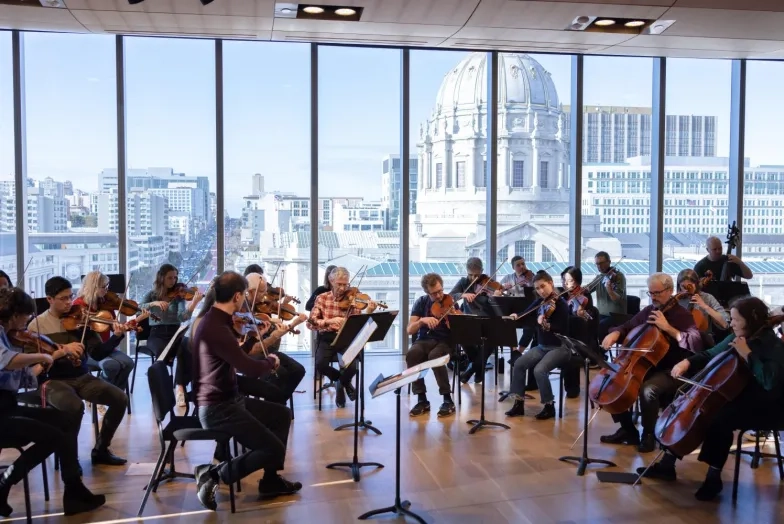In Conversation: Thalea String Quartet
Having just graduated from the Conservatory’s chamber music program, the Thalea String Quartet—SFCM’s quartet-in-residence for the past two years—reflects on their time at SFCM and looks to their expanding horizons. The Thalea’s violinists Christopher Whitley and Kumiko Sakamoto took the time to answer a few questions about the past and future.
1) Three of you have pursued other degrees at SFCM in addition to the Artist Certificate in Chamber Music. What are some of the most vivid memories you have of your time at Conservatory?
Christopher Whitley: I think some of our most vivid memories probably involve working with our teachers and the fantastic guest artists we had the opportunity to collaborate with. Performing the Mendelssohn Octet with the Borromeo Quartet, Chausson’s Concert for Violin, Piano, and String Quartet with Geoff Nuttall and Jeff LaDeur, performing alongside Pulitzer Prize-winning composer Caroline Shaw, and the Brahms Sextet with our teachers Jodi [Levitz] and Jennifer [Culp] are just some of the highlights of our time here. I personally have amazing memories of working with my teacher Ian Swensen and former chamber music faculty Mark Sokol, two incredible musicians who influence my music-making every day.
2) How do you feel the curriculum at SFCM has shaped the ensemble?
CW: The Conservatory has such a rich tradition of chamber music-making and places such a unique emphasis on ensemble playing that I think it was impossible not to be shaped by that history. The wealth of experience that exists in the chamber music faculty is difficult to find anywhere else and, as a result, we felt that the curriculum of our residency was exactly what we needed for success. As the graduate quartet-in-residence, we were given a lot of space and time to just sit in a room and rehearse. The Conservatory’s support allowed us to really focus on developing our ensemble. We had loads of time to work with the amazing chamber faculty and a ton of opportunities to work with really inspiring guest artists and collaborators. I can safely say that the Quartet wouldn’t be what it is today without our time at SFCM.
3) The Quartet has racked up quite a number of performances. Have any in particular stood out?
CW: We’ve been so fortunate to play concerts in all sorts of places for all sorts of audiences. We played works by Terry Riley and Caroline Shaw at the Kennedy Center, newly commissioned works from the Kronos Quartet at SFJAZZ, and we’ve been so lucky to bring string quartet music to children at schools across the Bay Area and reach new audiences at numerous house concerts across the city. Our tour of France last summer with Maestro Scott Sandmeier was another unforgettable experience. We’ve played with aerial silk dancers and are looking forward to an upcoming collaboration with the Joe Goode Performance Group at the Yerba Buena Center in June.
4) How has collaboration played a role in the development of the ensemble?
Kumiko Sakamoto: We’ve learned so much from having the opportunity to collaborate with our teachers and mentors and collaboration has also resulted in some very exciting projects for us. We developed a 48-hour composition marathon in collaboration with some formers students at SFCM where composers are given 48 hours to compose a brand new string quartet piece that we then workshop and perform. We’ve been involved in outreach projects in collaboration with Napa Valley Chamber music and were able to bring music presentations to schools in Napa. We’re looking forward to some very exciting collaborations with dancers and composers, including a commission funded by a grant from Chamber Music America. The commissioned piece is by New York-based composer Vincent Calianno and is scored for string quartet, electronics, and video. Collaboration has had a major role in our development and is a vital part of what we do.
5) What's next for the Quartet?
CW: We unfortunately had to miss our SFCM graduation, but we were in NYC attending the Juilliard Quartet Seminar. Up next is a really busy summer of travel and performance. After our collaboration with the Joe Goode Performance Group in June, we are off to Stanford to study with the St. Lawrence Quartet. Then we head to the Banff Centre in Alberta, Canada to work with the Miró and JACK quartets, after which we will spend two weeks in Bear Valley, CA as the resident quartet of the Bear Valley Music Festival. In the fall, we’ll be in the Bay Area pursuing a bunch of different projects including outreach, a house concert series, and various residency opportunities including a week-long residency at Avaloch Farm working with Dana Fonteneau, founder of the WholeHearted Musician.
6) Any advice for other aspiring quartets on the rise?
CW: One thing we were told when we first started out was that we had to find our “niche” or our specialty. There are a lot of amazing musicians and ensembles that specialize in new music, crossover music, or period music, but we just decided to try everything! We like to get weird! The Bay Area is an amazing place to try new things, work with new people, and gain a lot of new, exciting experiences. Collaborating and reaching beyond your comfort zone is the best way to grow as a musician and as a person, and in today’s musical world, versatility and adaptability are vital to building a successful career.
KS: Forming a quartet isn’t all about rehearsing and performing. A strong business mindset is as important to your success as a quartet as your playing ability. There are so many incredible young quartets in the world right now and you have to know what sets you apart from the other groups. It is so important to understand all of what goes into an ensemble outside of the rehearsal room. You are starting a business together and the more you can hone these types of skills, along with maintaining an intensive rehearsal schedule, the further you will go. Trust your quartet mates! You are on the same team. Make sure your individual visions for the quartet are in line with one another so your group vision can help you reach your biggest goals.



